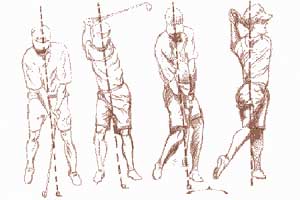Faculty to take sports beyond entertainment value
By Josh SchonwaldNews Office
 The first golf position (left) exhibits the elliptical axis of rotation; the second golf position (left and center) shows the golfer storing energy; the final two golf positions (right) depict the release of energy. |
The psychological phenomenon behind the Chicago Cubs’ unimaginable “choke.” The sociological explanation for fans who paint their face blue. The physics of Pedro Martinez’s curve ball. The economics behind Alex Rodriguez’s $20 million-plus salary. For the first time at Chicago, students in the College will get a unique chance to hear academic explanations for these and other beguiling phenomena and historic moments in sports history.
Debuting in the Winter Quarter, the interdisciplinary class, Sport, Society and Science, will draw 10 faculty members from across the University to examine elements of the world of sport and competition.
Though focused on sports, a form of entertainment, the class will not be easy, warned Allen Sanderson, Senior Lecturer in Economics.
“The fact that sports is entertainment doesn’t disqualify it from meriting serious academic scrutiny,” said Dennis Hutchinson, the William Rainey Harper Professor in the College, and Senior Lecturer in the Law School.
The class, which will have a cap of 50 students, with a preference for fourth-years, also will require completion of a mid-term and a final exam, research papers and problem sets. “There will be no field trips to Bulls games,” said Sanderson.
The workload will be heavy, and some of the University’s most well-known faculty members will teach the course. “To use a sports expression,” Sanderson said. “It’s an all-star roster.”
In the class’ first half, sociologist John MacAloon, Associate Dean of the Social Sciences Division and a leading expert on the Olympics, will discuss the history of sports in a lecture titled “Society and Sport;” John Kelly, Master of the Social Sciences Collegiate Division and Professor in Anthropology, will explore the crucial role that race has played in the world of sports; anthropologist Holly Sywers, a Harper fellow, will present some of her findings on the sociology and culture of the sports fan; Hutchinson, a Constitutional historian, will discuss the chief legal and public policy issues related to sports over the past century, such as the debate over whether or how much antitrust laws cover professional and college sports, and the controversies surrounding gender discrimination in high-school and college sports; and Sanderson will present two lectures on the economics of sports.
During the course’s second half, Starkey Duncan, Professor in Psychology, will explore the psychology of sports performance in “The Psychology of Competitions;” John Milton, Associate Professor in Neurology, will examine the neurological functions of athletic activities, such as hitting a golf ball; and Stephen Stigler, the Ernest DeWitt Burton Distinguished Service Professor in Statistics, will analyze the volumes of sports statistics published annually with an eye to what is valid and what is invalid. “It’s particularly timely,” said Sanderson, in light of baseball’s recent obsession with statistics, as documented in the book “Moneyball,” which explained how statistics shaped the Oakland A’s personnel decisions.
In the concluding lecture, physicist Thomas Rosenbaum, the James Franck Professor in Physics, will use physical concepts to explain the mechanics behind catching a fly ball and hitting a ball, and the characteristics of sports equipment, such as the dimples on a golf ball, or the shape of a football.
The class is the result of informal conversations between faculty members over the past several years. Sanderson, who has taught a course titled Economics and Sports for a decade, had, through his research, developed a growing interest in other aspects of sports-statistics, law, psychology, film and literature. In doing so, he had a conversation with Hutchinson, who expressed great enthusiasm about co-teaching a class. From there, Sanderson said, it was word of mouth. “A number of people in casual conversation expressed a great desire to do this.”
One enthusiastic participant, Rosenbaum, said of his interest: “It’s a natural congruence of professional interests and playing basketball hours on end growing up.”
Several of the participants are particularly excited about the unique opportunity to collaborate with colleagues from widely different fields. “Most of the lecturers plan on attending each other’s classes,” said Sanderson.
Some collaborators in Sport, Society and Science hope that using sports as a subject could be an engaging pedagogical tool.
“I hope that students will appreciate the general applicability of physics,” Rosenbaum said.
“The reason you want to throw a spiral pass in football is the same reason space-based ballistic missile defenses are unlikely to work!”
![[Chronicle]](/images/sidebar_header_oct06.gif)